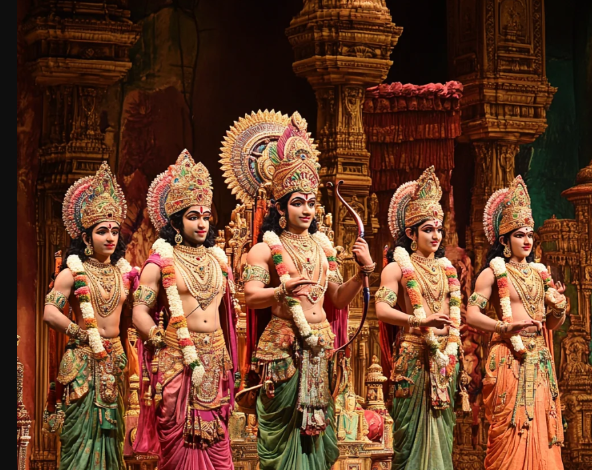
The Sage Tradition in the Ramcharitmanas
By: Rajendra Kapil
Fourth Chapter – Guru of the Raghu Dynasty, Rishi Vashistha
Rishi Vashistha was the esteemed royal guru of the Raghu dynasty, serving from the time of King Dilip, followed by King Aja, and later, King Dasharatha. During the Ramayana period, King Dasharatha never undertook any significant decision without consulting his royal guru. Rishi Vashistha is also considered a mind-born son of Brahma, born from his divine resolve. Through intense penance, Rishi Vashistha achieved great spiritual powers, including the possession of a Kamadhenu, a wish-fulfilling divine cow that eased many challenges for him.
In the Ramcharitmanas, Rishi Vashistha appears at several pivotal moments. For instance, in the Ayodhya Kanda, during a major crisis in the royal household, he offers wisdom and guidance to various members of the family. In the Uttarakanda, after Lord Rama returns from exile with Sita and Lakshman, it is Guru Vashistha who performs the coronation ceremony, seating Lord Rama on the throne of Ayodhya.
Rishi Vashistha’s Legacy and the Sapta Rishis
Rishi Vashistha’s greatness also lies in his inclusion among the Sapta Rishis (Seven Great Sages), who hold an eminent place in Indian culture. The Sapta Rishis are:
- Rishi Kashyapa
- Rishi Atri
- Rishi Bharadwaja
- Rishi Vishwamitra
- Rishi Gautama
- Rishi Vashistha
- Rishi Jamadagni
Vashistha and his wife Arundhati, known for their spiritual devotion, are celebrated as exemplars of dharma.
Key Episodes Featuring Rishi Vashistha
- Rishi Vishwamitra’s Request:
In the Bala Kanda, Rishi Vishwamitra approaches King Dasharatha to request Lord Rama and Lakshman’s help in dealing with the demons troubling his hermitage. Initially hesitant, King Dasharatha offers his entire army instead. Sensing the king’s paternal fears, Rishi Vashistha intervenes, reassuring him of Rama’s extraordinary strength and valor, ultimately convincing the king to agree.
Rishi Vashistha’s Words:
“Tarry not, O King, and prepare the assembly. It will be an auspicious day indeed when Rama is made the crown prince.”
- Coronation Plans and the Exile:
When King Dasharatha first decided to crown Rama as the crown prince, he sought Guru Vashistha’s blessings and advice. Guru Vashistha expressed great joy, calling it a moment of supreme fortune. However, fate intervened when Kaikeyi demanded Rama’s exile instead. Before departing for the forest, Rama visited Rishi Vashistha to seek his blessings. - Dasharatha’s Demise:
After Rama’s departure, King Dasharatha succumbed to grief. Guru Vashistha took charge during this difficult time, preserving the king’s body and sending messengers to summon Bharat and Shatrughna from their maternal grandparents’ home. Upon Bharat’s return, Guru Vashistha narrated the entire sequence of events, emphasizing Rama’s adherence to dharma and the Raghu dynasty’s tradition of honoring one’s word. - Bharat’s Visit to Rama:
When Bharat decided to visit Rama in the forest and convince him to return to Ayodhya, Guru Vashistha accompanied the royal family to ensure decorum and provide guidance. Despite Bharat’s heartfelt plea, Rama remained steadfast in fulfilling his 14-year exile to honor his father’s promise. It was Guru Vashistha who mediated, suggesting that Bharat take Rama’s sandals (charan paduka) as a symbol of his rule in Ayodhya until Rama’s return.
Rishi Vashistha’s Decision:
“The tradition of the Raghu dynasty dictates that a promise must be upheld at all costs. Rama must complete his exile, while Bharat should act as the custodian of Ayodhya.”
Through his wisdom and leadership, Rishi Vashistha played a critical role in guiding the Raghu dynasty through its darkest times. His actions ensured that dharma and familial bonds remained intact despite immense trials, solidifying his place as one of the greatest sages in Indian tradition.